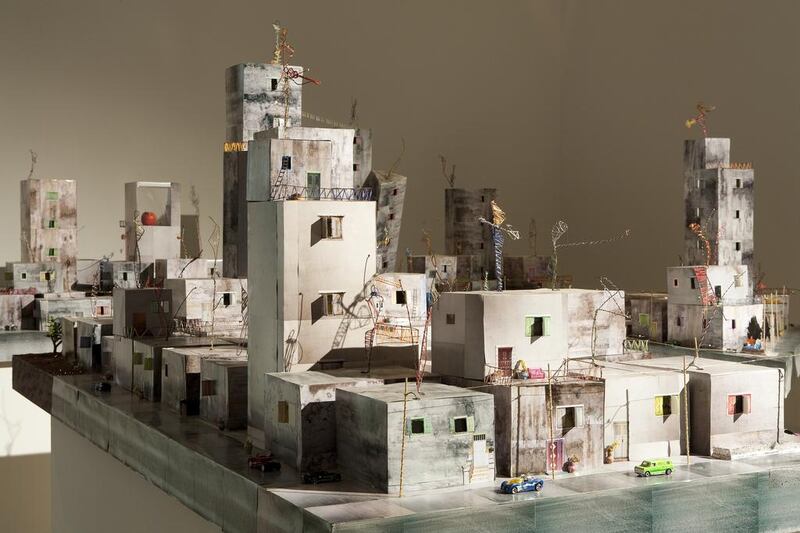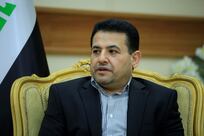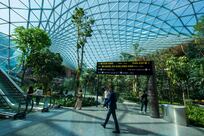A series of gleaming windows on a formerly dingy block of downtown New York has been stickered with signals of an unusual presence inside: a convincing simulation of a grand Emirati hotel. It consists of little more than sheets of photo-printed wallpaper and the tinkling of phantom piano keys, but there’s no mistaking the atmospheric effect. Giant staircases wind up towards gilded halls. Luxurious lights glimmer on the edges of elaborate moulding. A palm tree seems to sway in the presumably highly climate-controlled environs, and just above that is a sight even more odd: a line of painted portraits of eight people in traditional dress peering down.
All of them are members, in different garb, of GCC, the young artist collective responsible for the surreal architectural intervention in a setting so far from home. Though spread out in different cities (two of them live in New York, with others in Dubai, Lebanon, London and Kuwait), each of the members originally hails from the source of much regional interest in the New York art scene right now. The reason is Here and Elsewhere, an exhibition of contemporary art "from and about the Arab world", and the interest, like the show itself, is intense.
The exhibition opening last week drew a mass of oglers eager to see the latest that the New Museum, one of many recent additions to a new downtown skyline on the Bowery, has to offer. Since its founding in a different location in 1977, the museum has been an ambitious and progressive institution in a city that abounds with art. In recent years, especially, it has mounted some of New York's most probing and provocative shows. Here and Elsewhere counts as both, with 45 artists and collectives drawn from 12 different countries mostly in the Middle East and North Africa.
Attendees for the opening night included some of New York’s prime cultural movers: Klaus Biesenbach from the Museum of Modern Art, the gallerist Jeffrey Deitch, the Lincoln Center music programmer Bill Bragin, Jens Hoffmann from the Jewish Museum, the bearded conceptual artist Lawrence Weiner. The list went on, and in their midst were the smart and impish members of GCC, in the lobby and lapping up the attention.
“It’s like an interpretation of world-class luxury that’s lost in translation,” the group said of its work a couple of days before. (Though made up of individuals, GCC prefers to speak as one body.) “We play with the ideas of architectural dysmorphia and perception a lot.”
The initial idea for their inclusion in the show was to restage an earlier work called Amalgamated City, which features a fantasia of real and imagined buildings rising up in the Gulf in a similar combination of photographic-wallpaper collage and sound. But they wanted to do something different – something that would be both inviting and isolating for the audience in New York. So they transformed the lobby of the museum into the lobby of a sort of mongrel hotel, inspired by certain real palatial dwellings but abstracted and made even more extravagant. The title of the installation, made specially for the occasion, is The One and Only Madinat New Museum Royal Mirage.
“A big reason for this is a lot of the visual culture of the Gulf after oil,” the collective said. “They destroyed all the old cities, and there was no continuation except for this [meaning all the opulence]. It’s a sort of hazy memory of what happened that got blown up out of proportion.”
It’s a critique, to be sure, but also a sort of tribute, GCC insists: “We’re archaeologists. We excavate and recontextualise. But it gives us great pleasure to think about and talk about and research these things. We’re not taking it at face value. We’re not taking it so rigidly. But there is a sort of appreciation.”
GCC's rich mix of sentiments is part of a remarkably varied and volatile assembly enlisted for the Here and Elsewhere show. Of the hundreds of artworks on display on the New Museum's five floors, some are pointed and polemical, others contemplative and abstract. Still others are inspired and agitated and angry and mystified. The mixture is powerful and overwhelming, especially in a city that is seeing most of the art and participating artists for the first time.
“Part of the reason we did this show is both the excitement and the fear of ignorance,” said the New Museum curator Massimiliano Gioni, describing a state of exposure and awareness for which “you are getting a few signals but are completely ignorant”. He and his co-curator Natalie Bell were intrigued – “so we said: ‘Let’s embark on this and try to learn and try to make it available.’ It’s a process that starts by instinct and keeps growing and growing and slowly starts making sense.”
Part of the motivation at the idea stage was a sense that consolidated displays of art from the Arab world, while of increasing interest around the globe, were confined to international biennials and art fairs where any meaningful “sense of place” is erased. In the orbit of the art world, coordinates sometimes spin in a vacuum out of whack.
“I was getting annoyed by this phenomenon by which artists from certain countries in a way only existed in art fairs and biennials,” Gioni said. “This mode of internationalism is exciting, but it’s also getting a little suspicious at this point – the idea that we’re all the same, that we’re all together. I think the myth of an international community is a myth. I don’t believe in this innocent world of international biennials that have no use to represent cultures. I have no idea what it means to have an artist from Lebanon next to an American next to a Libyan. Is that a more complex understanding of the world, or just a flattening?”
Gioni knows the pros and cons of the global context. He has organised numerous exhibitions internationally and, last year, curated the roundly celebrated Venice Biennale. But it is at home at the New Museum that he has left his mark most indelibly, with a growing list of group shows and pioneering solo exhibitions that have a habit of shifting conversations about contemporary art, in New York and points beyond.
The notion of a show of Arab art is not without its liabilities. Deciding what constitutes “the Arab world”, for starters, is a fraught affair. Then there’s the question of what, if anything, such a designation might mean to the teeming mix of interests and impulses that artists from any locale share.
“I have refused shows in the past based on identity,” said Lamia Joreige, an artist based in Beirut, “but this one is different. We first met in Lebanon, and it’s very different when they come to the country where you live to do research. You always have reservations about an identity-based show, but that’s precisely where the work starts.”
Of prime importance to Joreige, who studied in the United States and knows New York well, was the chance to represent the complexity of her world. “What was interesting to me is that Americans don’t have a deep understanding of our region, not just the politics but the diversity,” she said. “I think this could make things change. It could help in understanding better the subtleties and diversities. America is so big by itself that the idea of understanding the rest of the world and looking at this ‘otherness’ is crucial.”
Joreige's contribution towards that goal is a stirring collection of video interviews and objects arranged behind glass; the subject of all the interviews is the Lebanese civil war, and the objects are totems or reminders of its ravages that each of the speakers chose. Objects include an old Walkman, a handbag decorated with Miss Piggy from The Muppets and a pocket knife, among many other curious and endearing things.
Representations of conflict and war make up a significant undercurrent of the exhibition, and questions of representation itself hover over everything in the show. The theme stated in the title Here and Elsewhere draws from a 1976 film by the French directors Jean-Luc Godard and Anne-Marie Miéville that incorporates footage shot for what was supposed to be a documentary expressing solidarity with the Palestinian cause. When they tried to edit the footage assembled at home, however, the filmmakers were hobbled by awareness of all the ways that images can reflect and refract reality but also elements of distortion and untruth.
Consciousness of such forces is increasingly important in our supersaturated media age, and it figures heavily in the art in the Here and Elsewhere show. In their catalogue essay, Gioni and co-curator Bell write, on the subject of mysterious photographs made with expired film by the Lebanese artist Ziad Antar: "The image itself seems to doubt its own existence as it floats to the surface with ectoplasmic evanescence." In his video work and a special performance presented live on opening night, the Iraqi artist Hiwa K plays with the imagery and associations of Once Upon a Time in the West, a classic spaghetti Western movie about early American expansion. "Somehow the myth of Westerns infiltrates our relations," said the artist, who collaborated on his work with a former American soldier he met in Germany. "It's so kitschy, so overdosed."
Meditations on the meaning and transmission of images abound, but so do works of less media-minded kinds. For his collection of spellbinding drawings, the Moroccan artist Mohamed Larbi Rahali went to work on a most unusual material: the tiny cardboard insides of more than 300 matchboxes. For a piece that incorporates video and works on paper, Abdullah Al Saadi, from Khor Fakkan, travelled the desert with a donkey and summoned what he saw with terrestrial washes of watercolour and ink. In one of the largest presentations in the show, the Palestinian artist Wafa Hourani built a sprawling miniature model of the Qalandia refugee camp as it might exist – much more peacefully and serenely – in the year 2087.
For a show-stopping assemblage of sculptures, Hassan Sharif, from Dubai, collected plastics, textiles, pieces of foam – detritus from development, essentially – and arranged them in suggestive, disquieting forms. “I see him as one of our forebears,” a member of the GCC collective said of the influential elder statesman. (Sharif is 63 years old.) “He’s dealing with the materiality of the Gulf in a very different way than we are, but there are overlapping ideas. It’s useful and important to see these trajectories.”
For ages, the consensus about New York has been that it likes to regard itself as the centre of the world. An awful lot happens here, the city seems to think, and much of what does not at least aspires to.
Or so they say. The truth is quite a bit more complicated. As a metropolis full of people from everywhere else, New York has always had a decentred sense of self. And reasons ranging from violent upheaval (the epochal September 11 attack) to numbing overpricedness (rising property rates pretty much everywhere) to increased sensitivity to commanding financial markets overseas (China) have dressed New York down. Such a condition is, by many different counts, for the better, especially in terms of the city’s potential for border-crossing curiosity and more specifically its changing status as a capital of the arts.
“Today there isn’t a capital of the art world, it seems to me,” said Etel Adnan, an 89-year-old Lebanese artist in the New Museum show (as well as the nearby Whitney Biennial earlier this year). “Today the focus is not in one place but many.”
For GCC, younger by many decades, New York stands out as a central hub most prominently in the past. “It’s becoming more of an equal playing field,” the collective said. “When we show something in Sharjah, it’s just as important as showing something in New York or Beijing. We learnt a lot from the experience of doing a show in Kuwait about how our work is perceived and how it’s read. We’re interested in this decentralisation.”
Still, it's New York – home of Jackson Pollock and abstract expressionism, Andy Warhol and pop art, SoHo in the 1970s, etc – so they're happy to take part, GCC said. And the city seems happy to have them, too. After lashing out against "the provincial nature of the New York art world" and expressing leeriness over "shows that lump sundry unalike cultures together", a highly favourable New York Times review of Here and Elsewhere praised it as a "chance, still too seldom offered by our museums, to be a global citizen". A writer for The Economist opined that the show "leaves a lasting impression and confirms how art can create a historical record".
The show is not without precedent in New York. In 2006, the Museum of Modern Art staged Without Boundary: Seventeen Ways of Looking as a survey of art from the Islamic world, and three years later came Iran Inside Out, a well-regarded exhibition at the Chelsea Art Museum. The past few years have greeted a grand renovation of the spacious wing for Art of the Arab Lands, Turkey, Iran, Central Asia and Later South Asia at the Metropolitan Museum of Art, as well as singular activities at galleries around town. When it opens in a Chelsea gallery in September, a show titled Portraits: Reflections by Emerging Iranian Artists will overlap with the New Museum exhibition for a spell.
Still, Here and Elsewhere stands as different and distinct – more pointed, more assertive, more free to be uncertain and curious and honest about its yearning for context in a realm where context is not easy to come by. The catalogue publication for the show is itself a welcome addition to the domain (especially for its editorial collaboration with the editors of the excellent journal Bidoun), and a series of public programmes will accompany the exhibit during its run through the end of September.
The first such programme was a panel discussion with the curator Bell and three artists in her midst. Only two were physically there, as one – Khaled Jarrar – had been prevented days earlier from flying to New York from Palestine. Israeli security forces had stopped him, citing what Jarrar confusedly called “security reasons”, and the incident had become something of a minor media sensation around the opening of the show.
Jarrar’s art had not been bound, though, and neither had his voice, thanks to a live feed over the internet. Along with Joreige, from Beirut, and a member of the anonymous Syrian film collective Abounaddara, conversation ventured between matters of struggle, communication, and creation in an art world increasingly open to work from their disparate homes.
Upon first leaning into his microphone, the member of Abounaddara murmured, quietly: “I was told everybody here speaks Arabic, so I will speak Arabic.” The audience squirmed for an instant, all but audibly gasped, and then, with a rise of realisation, broke into a spot of laughter shared among all. A sense of communion had been established, and then the room went silent and clear. All eyes and ears were poised to pay attention to a type of global presence whose voice is growing louder.
Andy Battaglia is a regular contributor to The Review.
[ thereview@thenational.ae ]





